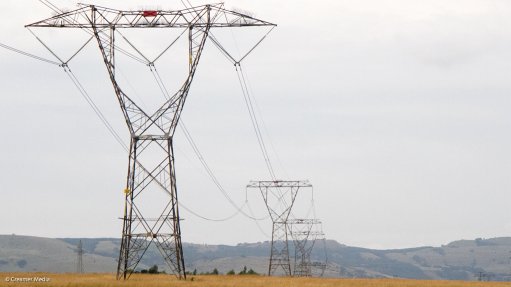
Photo by: Creamer Media
As Eskom and the National Energy Regulator of South Africa (Nersa) head for another legal showdown, attention has turned to the legality and practicality of the regulator’s “preferred option” and timetable for ensuring that a tariff determination is made in time for implementation on April 1 next year.
In a letter to Eskom, dated November 12, Nersa outlined four options, including:
- the Energy Regulator and Eskom agreeing, under Option 1, on pricing principles, then consulting with the public using the agreed principles to settle on a percentage increase;
- Eskom and the Energy Regulator reaching an agreement, under Option 2, on a percentage increase and then consulting the public on that agreement;
- Determining, under Option 3, a percentage increased as part of a court-ordered settlement, in lieu of the R59-billion still owed to Eskom; or
- Option 4, which involves using the pricing ‘principles’ currently under consultation to determine trading tariffs for Eskom’s generation, transmission and distribution units, which are in the process of being restructured into separate businesses.
Nersa has indicated that ‘Option 4’ is its preferred remedy, arguing that such an approach would be premised on the principles that would inform a future multiyear price determination (MYPD) methodology.
Those principles are currently the subject of a public consultation process, which Nersa says will be finalised by November 29.
No new methodology has been consulted or agreed, even though the regulator has stated that the MYPD4 methodology, on which Eskom’s MYPD5 application is based, has expired.
Eskom made its MYPD5 submission, which covers the three financial years from 2022/23 to 2024/25, on June 2.
On September 30, however, the Energy Regulator rejected the submission and, on October 5, indicated that only a single-year application would be considered for 2022/23, “preferably based on the principles of the revised MYPD5 methodology”.
Eskom then approached the Gauteng High Court to have the regulator’s decision to reject its revenue application set aside for being “patently irrational and unlawful”.
“It is wholly irrational for Nersa now to expect Eskom to make a fresh application in terms of as yet undisclosed principles that may or may not inform a new methodology that may or may not be adopted at some stage in the future,” Eskom said in a founding affidavit deposed by CFO Calib Cassim, who described it as a “Kafkaesque state of affairs”.
In an answering affidavit, Nersa full-time regulatory member Nhlanhla Gumede argues that the current MYPD methodology was developed for the determination of tariffs for the period ending on March 31, 2022 “and not beyond” and that Eskom’s MYPD5 application was, thus, submitted “prematurely”.
“Eskom could have been under no illusion as to Nersa’s view regarding procedure. Their feigned surprise at the decision made on 30 September 2021 is therefore not understood,” Gumede states.
Eskom’s MYPD5 application, he adds, does not reflect the restructuring of Eskom into three separate divisions and can, thus, not achieve an “activity based” tariff determination.
The Nersa affidavit argues that ‘Option 4’ can be implemented by early March as would be required for Parliamentary approval, as it does not require Eskom to “reinvent the whole application”.
“[Eskom] would just need to repackage or adjust their existing application in a manner that satisfies the principles approved by the regulator: the historical costs will still be the same costs as in the present application.
“Future expenditure will be divided into various divisions. The interrelationship of the divisions, whether separate corporate entities or not, will have to be determined and considered.”
In his replying affidavit, Cassim argues that Nersa is intent on embarking on a process that is “manifestly unlawful”, because it can be completed only by defying provisions of the Municipal Finance Management Act (MFMA).
Cassim notes that the position outlined in the answering affidavit is also at odds with
Gumede’s public statements of November 12, the same day that Nersa’s answering affidavit was submitted.
In Eskom’s version of that public statement, Gumede apologised for creating the impression that “the proposed changes to the methodology or the underlying principles are intended for implementation on the 1st of April next year”.
The Eskom affidavit quotes Gumede further as saying: “Although we may, or we may have in our exuberance, perhaps communicated or came across that this is what we’re saying but that was never the case because there are many dependencies and policy positions that would have needed to be clarified before the principles that might be proposed can then be implemented. Assuming that they will be found acceptable by stakeholders.”
Cassim describes Option 4, and its associated timetable, as unlawful and unrealistic given that Eskom would not be able to submit a new tariff application before it has given the National Treasury and the South African Local Government Association at least 40 days to consider the new tariff application and provide written comments thereon.
“If the 40-day consultation period in Section 42(2) of the MFMA is not to be defied, the entire process from submission of application to decision would have to be commenced and finalised between 20 February and 2 March (a period of 10 days). This is simply unrealistic,” the Eskom affidavit reads.
“An additional major flaw in Nersa’s approach is that Eskom cannot make, or indeed even update, its application based on ‘principles’. It needs a clear indication of the methodology against which Nersa is going to assess the application it is going to make.”
Eskom also attacks the other three options as unlawful, noting that Options 1 and 2 imply collusion between Nersa and Eskom in setting the tariff, while Option 3 “seeks to avoid any public consultation on the tariff increase by packaging a privately agreed tariff increase as a
Court order in settlement of a dispute with Eskom”.
No date has yet been set for the hearing, which is expected to take place either in late November or early December, with Judge Jody Kollapen to hear the matter.